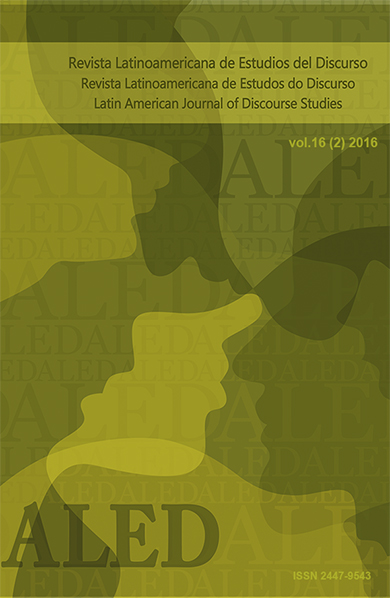El tarot como discurso de contestación en la caricaturista venezolana Rayma
Palabras clave:
análisis crítico del discurso. discurso multimodal. humor editorial. discurso de contestación. tarot. RAYMA.Resumen
El hecho ocurrido el 7 de enero de 2015, cuando dos fanáticos religiosos armados entraron a las oficinas de Charlie Hebdo en París, asesinando a once personas e hiriendo a otras tantas (en su mayoría caricaturistas y periodistas), nos vuelve a poner en evidencia que no hay “nada más demoledor” que el humor. Me propongo un estudio que combina el análisis crítico del discurso (Fairclough 1995, 2001, van Dijk 2000, 2011), la teoría sobre los discursos multimodales (Kress y van Leeuwen 2001, 2006) y los aportes de la teoría general del humor verbal (Attardo 1994, Ruiz Gurillo 2012) a una serie de 27 caricaturas publicadas entre el 2 y el 30 de mayo de 2014 en el diario El Universal (Caracas, Venezuela) bajo el título de “Rayma en Tarot…”. Las mismas aparecieron dentro del clima de protestas estudiantiles contra el gobierno del presidente Nicolás Maduro y la subsiguiente respuesta represiva. La caricatura que de por sí es un género connotativo se exponencia al asumir la caricaturista la posición de nigromante y, su discurso, la función adivinatoria del tarot. Para tal fin, se vale de las figuras cónsonas con este arte adivinatorio adaptadas a sus viñetas y desentrañar su sentido requerirá una hermenéutica que la caricaturista solo quisiera revelar mediante la relación adivinatoria con el lector-país. Las conclusiones de este estudio se orientarán hacia las características y función de contestación del discurso de la caricatura editorial.
Descargas
Citas
Adam, J.M. y Bonhomme, M. 1997. L´argumentation publicitaire. Rhétorique de l´éloge et de la persuasión. Paris: Nathan Université.
Attardo, S. 1994. Linguistic theories of humor. Berlin-New York: Mouton de Gruyter.
Charaudeau, P. (ed.) 2015. Humour et engagement politique. Condé-Sur-Noireau, France: Lambert-Lucas.
Cohn, N. 2013. The visual language of comics. London: Bloomsbury.
Crawford, M. 2003. Gender and humor in social context. Journal of Pragmatics 35: 1413-1430.
Fairclough, N. 1995. Critical discourse analysis: The critical study of language. Harlow, England: Longman.
Fairclough, N. 2001. Language and power. Harlow, England: Longman.
Figueras, C. 2013. La construcción de identidades en narrativas multimodales de trastornos de la conducta alimentaria. Discurso y sociedad. 7, 1: 148-199.
Freud, S. 1905. El chiste y su relación con lo inconsciente. (versión Kindle)
Johnstone, B. 2008. Discourse analysis. Victoria, Australia: Blackwell.
Kress, G. y van Leeuwen, T. 2001. Multimodal discourse. The modes and media of contemporary communication. London: Hodder Education.
Kress, G.R. y van Leeuwen, T. 2006. Reading images: The grammar of graphic design (2a ed,). London: Routledge.
Paz, Y. 2014. El Presidente está enfermo ¿Qué tendrá el Presidente?: La enfermedad y sus metáforas en el discurso de Hugo Chávez Frías. Discurso y sociedad. 8, 2: 299 325.
Ruiz Gurillo, L. 2012. La lingüística del humor en español. Madrid: Arco/Libros.
Steeves, J. B. 2004. Imaging bodies: Merleau-Ponty’s philosophy of imagination. Pittsburg, Pennsylvania: Duquesne UP.
Suprani, R. (2015). Drawing a line (Oslo Freedom Forum) https:// www.youtube.com/watch?v=_hzWyk5Lhz4&ebc=ANyPxKqrgbz8fIekErcjPQVXHeTiFERWM-8XVMwClwoA_dbsJ4byax-PzMZI37ZUDpE6TpELq69apGmKLUGy52fbRafOu_GNw Consulta 3/17/2016.
Valloatto, S. 2015. Caricaturistas, soldados de la democracia https://www.youtube.com/watch?v=I5ql3vNprVc https://www.youtube.com/watch?v=9d_oFrwgzRc Consulta 3/19/2016.
van Dijk, T. (ed.) 2000. Discourse as social interaction. London: Sage.
van Dijk, T. 2011. Ideología y discurso. Barcelona: Ariel Lingüística.
Vieira, L. D. 2007. Humor en editoriales de TalCual. Texto e imagen en el discurso político. Revista Latinoamericana de Estudios del Discurso (ALED) 7, 1: 95-114.
Vivero García, M. D. y del Río Barredo, M. J. 2015. La caricature dans les cultures française et espagnole. Quand les dessinateurs prennent position contre les élites. En Patrick Charaudeau (ed.) Humour et engagement politique, pp. 69-86. Condé-Sur-Noireau, France: Lambert-Lucas.
Weber, M. 2003. Le savant el le politique. Paris: La Découverte.
Descargas
Publicado
Cómo citar
Número
Sección
Licencia

Esta obra está bajo una licencia internacional Creative Commons Atribución-NoComercial-SinDerivadas 4.0.
Los/as autores/as conservan los derechos de autor/a y garantizan a RALED el derecho de ser la primera publicación del trabajo al igual que licenciado bajo una Creative Commons Attribution License BY-NC-ND 4.0 que permite a otros compartir el trabajo con un reconocimiento de la autoría del trabajo, copiar y redistribuir el material en cualquier medio o formato.
Os/As autores/as conservam os direitos autorais e garantem a RALED o direito de ser a primeira publicação do trabalho licenciado por uma Creative Commons Attribution License BY-NC-ND 4.0 que permite compartilhar o trabalho com reconhecimento de sua autoria e cópia e redistribuição do material em qualquer meio ou formato.




